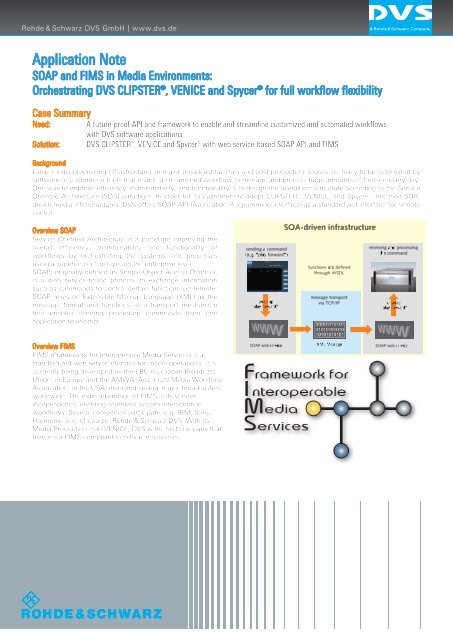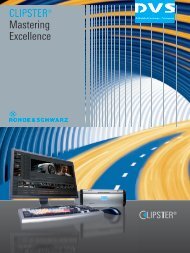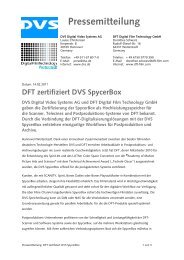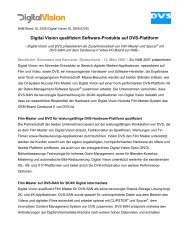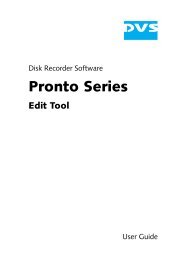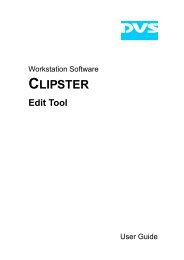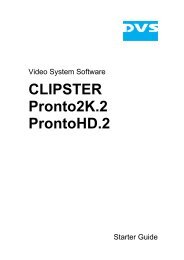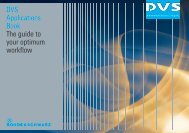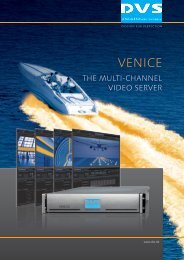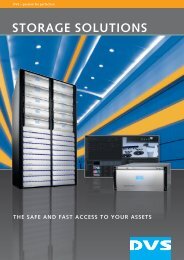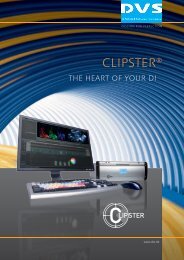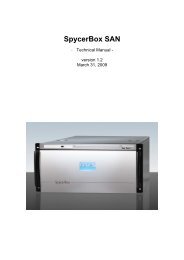PDF-Download - DVS
PDF-Download - DVS
PDF-Download - DVS
Create successful ePaper yourself
Turn your PDF publications into a flip-book with our unique Google optimized e-Paper software.
Rohde & Schwarz <strong>DVS</strong> GmbH | www.dvs.de<br />
Application Note<br />
SOAP and FIMS in Media Environments:<br />
Orchestrating <strong>DVS</strong> CLIPSTER®, VENICE and Spycer® for full workflow flexibility<br />
Case Summary<br />
Need:<br />
Solution:<br />
A future-proof API and framework to enable and streamline customized and automated workflows<br />
with <strong>DVS</strong> software applications<br />
<strong>DVS</strong> CLIPSTER®, VENICE and Spycer® with web service-based SOAP API and FIMS<br />
Background<br />
Large media processing infrastructures in major broadcast facilities and post production houses are likely to be automated by<br />
software or customized tools that enable a streamlined workflow to manage and process huge amounts of footage every day.<br />
One way to improve efficiency, maintainability, and functionality is to design the overall infrastructure according to the Service<br />
Oriented Architecture (SOA) paradigm. In order for its customers to adopt CLIPSTER®, VENICE, and Spycer® into their SOAdriven<br />
media infrastructures, <strong>DVS</strong> offers SOAP API (Application Programming Interface) as a standardized interface for remote<br />
control.<br />
Overview SOAP<br />
Service Oriented Architecture is a paradigm improving the<br />
overall efficiency, maintainability and functionality of<br />
workflows by orchestrating the systems and processes<br />
using a superior control layer on the enterprise level.<br />
SOAP, originally defined as Simple Object Access Protocol,<br />
is a web service-based protocol to exchange information<br />
such as commands to control certain functions via remote.<br />
SOAP relies on Extensible Markup Language (XML) as the<br />
message format and functions as a transport mechanism<br />
that enables sending procedure commands from one<br />
application to another.<br />
Overview FIMS<br />
FIMS (Framework for Interoperable Media Services) is a<br />
standardized web server interface for media operations. It is<br />
currently being developed by the EBU (European Broadcast<br />
Union) in Europe and the AMWA (Advanced Media Workflow<br />
Association) in the USA, involving several major broadcasters<br />
worldwide. The main advantage of FIMS is its vendor<br />
independence, enabling seamless system interaction in<br />
workflows. Several companies participate, e.g. IBM, Sony,<br />
Harmonic and, of course, Rohde & Schwarz <strong>DVS</strong>. With its<br />
Media Production Hub VENICE, <strong>DVS</strong> is the first company that<br />
features a FIMS-compliant interface in a system.
Rohde & Schwarz <strong>DVS</strong> GmbH | www.dvs.de<br />
Using SOAP and FIMS<br />
In order to use the SOAP interface to remote control<br />
CLIPSTER®, VENICE, and Spycer®, it is possible to either<br />
implement the SOAP functionality into an existing software<br />
application or a stand-alone web-based application. One<br />
advantage of a SOA-driven infrastructure is the use of<br />
open formats instead of proprietary structures as<br />
system components. <strong>DVS</strong> products rely on open<br />
standards. Project files, for instance, are being stored in the<br />
XML format, allowing customization on the user<br />
level. The available functions in CLIPSTER®,<br />
VENICE, and Spycer® that can be used via remote<br />
control are standardized using the Web Services<br />
Description Language (WSDL). With the SOA<br />
paradigm it is possible to orchestrate multiple <strong>DVS</strong> CLIPSTER®, <strong>DVS</strong> VENICE, and <strong>DVS</strong> Spycer® installations from one single<br />
SOAP application. The conjunction of the SOA architecture together with FIMS leads to improved workflow flexibility. In the<br />
broadcast and post production business, the traditional architecture of a production system shows proprietary point-to-point<br />
connections. This not only slows down the workflow but also brings along high effort for the initial integration. Changing the<br />
workflow or its components becomes a very demanding task, followed by high costs and a general inflexibility. SOA<br />
architecture with FIMS on the other hand, offers versatile applications and services – thanks to one single, defined<br />
communication interface. This setup allows for easy changes in the workflow and its components. The benefits are clear: low<br />
costs and full workflow flexibility.<br />
<strong>DVS</strong> CLIPSTER®<br />
As the heart of the DI process, <strong>DVS</strong>’s workstation CLIPSTER® can be<br />
used in an even more efficient way with SOAP. CLIPSTER® offers a<br />
variety of functions, controllable through the API. For example, SOAP<br />
offers control in the finalizing process for all available file formats. This<br />
even includes the fast generation of high-quality DCPs (Digital Cinema<br />
Packages) thanks to <strong>DVS</strong>’s unique hardware acceleration. Furthermore,<br />
hardware-based zoom and pan can be automated this way. On top of<br />
this, multiple versions of the same footage source can be created in a<br />
single run when orchestrated via SOAP.<br />
<strong>DVS</strong> VENICE<br />
The Media Production Hub VENICE manages classic video server tasks<br />
such as HD-SDI ingest and studio playout combined with intelligent filebased<br />
features like file ingest, transcoding and media transfer operations.<br />
The growing need for multiple video formats and codecs in a broadcast<br />
studio environment is easily handled with VENICE’s flexible multi-format<br />
video and codec pipeline for each channel. Thanks to its open platform<br />
and file system architecture, VENICE can seamlessly be integrated into<br />
any file-based broadcast production environment. VENICE offers<br />
continuous optimization of efficiency in your workflows – in a single<br />
system. VENICE is the first system worldwide to have integrated the<br />
open, web-service standard FIMS. VENICE offers several services via<br />
FIMS, e.g. “Capture” and “Transform”. With its SOAP interface, VENICE<br />
can easily be automated. Templates facilitate the broadcast workflow by defining different types and lengths of production.<br />
Content can be imported, edited, automatically titled, managed and delivered to VENICE or third-party editing clients without<br />
latency. Running on an open source Linux® operating system, VENICE clearly follows the SOA paradigm.<br />
<strong>DVS</strong> Spycer®<br />
The SOAP API enables automation of and remote access to Spycer’s powerful content control feature set. Especially when it<br />
comes to file system or network operations, <strong>DVS</strong> Spycer® provides a sophisticated functionality set. For instance, using<br />
Spycer’s high-speed copying process with enhanced algorithms is an ideal way to move around data within the company<br />
infrastructure. With Spycer®, scanning the content’s metadata, extracting it into the database, as well as managing and<br />
finding footage on large storage installations becomes much more efficient.<br />
Customize your workflow<br />
Are you interested in more detailed information on how to use SOAP with FIMS to customize your workflow? Would you like<br />
to know which remote capabilities <strong>DVS</strong> can offer you? Don’t hesitate to contact your local <strong>DVS</strong> representative.<br />
Copyright © 2013, all contents by Rohde & Schwarz <strong>DVS</strong> GmbH. Specifications<br />
and data are subject to change without notice. Some features may be part of<br />
optional or future packages. All trademarks used herein, whether recognized or<br />
not, are the properties of their respective owners.


